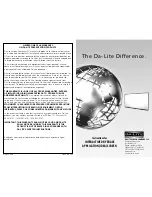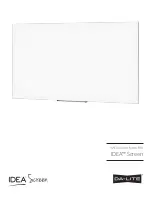
INSTALLATION & SETUP
2-6
CP2000-X User Manual
020-100031-01 Rev. 1 (03-2009)
Figure 2.7. Audience Coverage with a Flat Screen
NOTE:
CP2000-X
high-contrast lenses are designed primarily for use with flat
screens, but the projector’s depth-of-field range allows the lens to be focused on
mildly curved screens as well. While focus remains sharp in the corners, there may
be significant pincushion distortion, primarily at the top of the screen
.
Rear Screen Installations
There are two basic types of rear screens: diffused and optical. A
diffused
rear screen
has a surface that spreads the light striking it. Purely diffused screens have a gain of
less than 1. The main advantage of the diffused screen is its wide viewing angle,
similar to that of a flat screen for front screen projection.
Optical
rear screens take
light from the projector and redirect it to increase the light intensity at the front of the
screen. This reduces it in other areas, and creates a viewing cone similar to that of a
curved front screen installation.
To summarize, optical screens are better suited for brightly lit rooms where the
audience is situated within the viewing cone. Diffused screens may be better suited
when a wide viewing angle is required but there is low ambient room lighting.
Screen size (image size) may be up to 145 feet across, depending on your lens and
ambient light level. Choose a screen size appropriate for your lens and application.
Keep in mind that if the projector will be used to display much text information, the
image size must allow the audience to recognize all text clearly. The eye usually sees
a letter clearly if eye-to-text distance is less than 150 times the height of the letter. In
other words, small text that is simply located too far from the eye will be illegible no
matter how sharply and clearly it is displayed.
NOTE:
Screens/images are most described according to their horizontal (
)
screen width. Aspect ratio is also specified if it is anything other than 4:3 (see
below). The older “diagonal screen size” typically used for 4:3 displays such as
televisions and monitors is less commonly used for large projection screens.
Screen Size
Summary of Contents for CP2000-X
Page 1: ...CP2000 X U S E R M A N U A L 020 100031 01...
Page 2: ......
Page 42: ......
Page 102: ......
Page 112: ......
Page 130: ......
Page 135: ...SPECIFICATIONS CP2000 X User Manual 8 5 020 100031 01 Rev 1 03 2009...
Page 160: ......















































